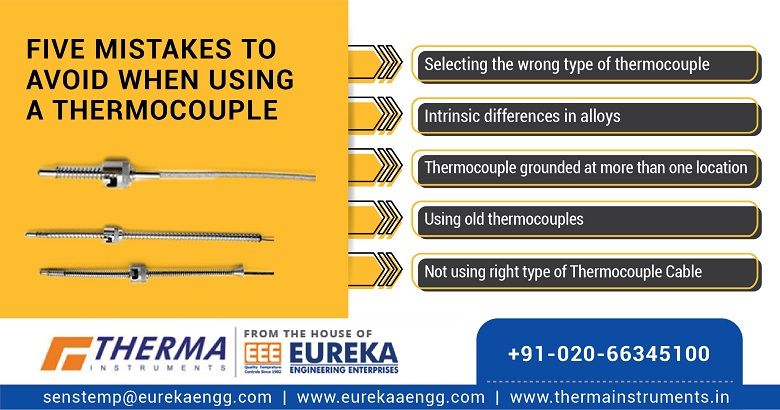Five Mistakes to Avoid when Using a Thermocouple
Published on April 09, 2020

What is a thermocouple?
A thermocouple is an electrical instrument used to measure temperature. It consists of two wires made of different metals which are joined together at one end, known as the measurement junction. The other end, where the wires are separate, is connected to signal conditioning circuitry traces, usually made of copper. This junction between the thermocouple metals and the copper traces is called the reference junction.
Avoiding mistakes while using a thermocouple
Thermocouples are the industry-standard method for measuring a wide range of temperatures, from boilers and ovens to aircraft engines. However, they are notoriously difficult to operate because of their complex behaviour. Here are five mistakes to avoid while using a thermocouple, in order to get an accurate reading:
- Selecting the wrong type of thermocouple: There are many types of thermocouples- types K, J, N, E, T, R, S and B- with different ranges, accuracies and electrical outputs. It is vital to choose the right type of thermocouple when setting the transmitter. Fortunately, thermocouples are usually colour-coded by type, so one would only have to note the colour of the thermocouple jacket and match the settings on the transmitter.
- Intrinsic differences in alloys: No two pairs of thermocouple wires have the same composition. Alloy composition ratios vary during manufacturing, so some inaccuracy is unavoidable. Most thermocouples are accuracy within 1% of the actual temperature, which is good enough for most cases. However, if 100% accuracy is essential, thermocouples with special-limit wires should be used. Special-limit wires have negligible impurity and their alloy ratios are consistent.
- Thermocouple grounded at more than one location: A thermocouple should be grounded only at one location. Otherwise, there is a risk of a “ground loop” being created, where current will keep flowing through the thermocouple from one ground to another. This could create electromagnetic fields that could hamper accuracy. To avoid this, either the transmitter or the controller should be grounded, but never both.
- Using old thermocouples: Over time, thermocouples lose their accuracy. Exposure to differing temperatures, cyclic measurements and frequency of the cycles affect the metallurgy of the thermocouples, which may lead to inaccuracies up to 20°F. To avoid this, thermocouples should be replaced after regular periods.
- Not using right type of Thermocouple Cable : Temperature is displayed by Indicator, Controller, Data Logger ..etc , which are located in Control rooms , far from Thermocouples. Cables are required to connect Thermocouples to the measuring Instruments. Use of Normal Copper cables causes large error. To avoid this Thermocouple Extension Cables and Thermocouple Compensating cables are preferred.
Eureka Engineering Enterprises, a leading thermocouple manufacturer in india, provides robust thermocouples with high accuracy. Eureka Engineering Enterprises is a certified temperature sensor manufacturers in india that specializes in manufacturing and supplying temperature measurement instruments like RTD, thermocouple sensor, thermowell and control systems. Equipped with modern infrastructure and expertise, Eureka Engineering Enterprises has been providing an innovative, quality solutions to customers for more than 30 years.
Have Any Questions on temperature sensing and control systems
Ask Our Experts!
Recent Posts
Looking for high-grade Temperature Sensors and Thermocouples for Aluminum Smelters?
Looking for the Best Temperature Measurement Solutions for Your Cement Plant? Eureka Has Got You Covered!
Things to Remember for Selecting Right Thermocouple Sheath Material for Molten Metal
Things to Consider for Protective Coating on Thermocouple Sheaths
Things to remember for Choosing Thermocouple Connectors
Things to Remember while installing Thermocouples and RTDs with Compression Fitting
Ever Wondered How Thermocouple Works
Five Mistakes to Avoid when Using a Thermocouple
Five Hacks of using Thermocouple at your shop floor
All Rights Reserved © EUREKA ENGINEERING ENTERPRISES - 2019
Engineered by The Impals